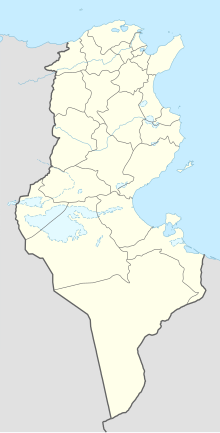Bou Hedma National Park
Coordinates: 34 ° 25 ′ N , 9 ° 30 ′ E
The Bou Hedma National Park is a national park in Tunisia . The park is located 85 kilometers east of Gafsa in the central part of the country. It is located a few kilometers southwest of the city of Meknessi in the foothills of the Sahara Atlas .
The reserve is both a biosphere reserve and a national park. It covers an area of 170 square kilometers, of which 88 square kilometers make up the core area. The rest consists of buffer zones and border areas. The vegetation is predominantly dry, Mediterranean , partly steppe-like. The steppes emerged from degenerate juniper forests . Typical bank vegetation occurs along rivers and wadis . Acacia savannahs also occur. The altitudes range from 80 to 814 m above sea level.
Wildlife
In the fenced-in areas of the reserve, some large animal species were released that were once typical of the arid zones of North Africa, but have now almost disappeared. These include mendes antelopes , saber antelopes , Dama gazelles and ostriches . The Damaga cells were released into the wild in the 1990s. In 2006, the population in the park was given as 17, a year earlier the population of the saber antelope was estimated at around 130 animals. The Mendes antelopes, which by nature are more adapted to even drier desert areas, seem to be inferior to the stronger saber antelopes in the area, which led to a decline in the Mendes antelope population. Therefore, some animals have been transferred to other protected areas such as Jebil National Park and Senghar National Park .
Also mane sheep are kept in fenced areas. However, some animals escaped into the surrounding areas of the park. The Dorcas gazelle occurs wild in the park . Other antelope species that are missing today but are considered potential species in the area are the Cuvier's gazelle and the hartebeest . However, the North African subspecies of the hartebeest has become extinct, which is why one would have to resort to foreign subspecies in the event of a release into the wild.
Usage and human influences
Around 1400 people live in the area with a stable population. The use as pasture and partly also arable land creates problems for the nature of the reserve. Among other things, erosion is favored. In the meantime there are attempts to counteract desertification by supporting original woody species. An ecology museum was also set up. Especially in the two large fenced-in areas, which are 20 and 10 square kilometers in size, the vegetation has recovered because overgrazing by pets has been stopped.
Web links
- UNESCO MAB Biosphere Reserves Directory: Djebel Bou-Hedma
- Photos of the national park at www.kultur.de
- World Database on Protected Areas - Bou-Hedma National Park (English)
Individual evidence
- ↑ Addax nasomaculatus in the endangered Red List species the IUCN 2010. Posted by: Newby, J. & supervisor, T., 2008. Accessed on 18 4. 2011th
- ^ Iain J. Gordon & J. Paul Gill: Reintroduction of Scimitar-horned oryx Oryx dammah to Bou-Hedma National Park, Tunisia . International Zoo Yearbook. Volume 32, Issue 1, pages 69–73, January 1993 doi : 10.1111 / j.1748-1090.1993.tb03517.x .
- ↑ Nanger then in the endangered Red List species the IUCN 2010 Posted by: J. Newby, T. & F. supervisor Lamarque, 2005. Retrieved on 18 4. 2011th
- ↑ Oryx dammah in the Red List of Threatened Species of the IUCN 2010. Posted by: IUCN SSC Antelope Specialist Group, 2008. Accessed on 18 4. 2011th
- ↑ Information on the status of the Mendes antelope on wildaddax.org .
- ↑ Shackleton, D., M., (ed.) And the IUCN / SSC Caprinae Specialist Group, 1997. Wild Sheep and Goats and their Relatives. Status Survey and Conservation Action Plan for Caprinae. IUCN, Gland, Switzerland and Cambridge, UK. P. 176
- ^ A b D. P. Mallon, SC Kingswood: Antelopes, North Africa, the Middle East, and Asia: Global Survey and Regional Action Plans: North Africa, the Middle East and Asia (Pt. 4). Union Internationale pour la Conservation de la Nature et de ses Ressources, Switzerland (January 2001). ISBN 2831705940 .

